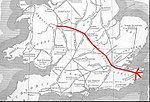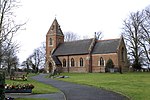Fenny Drayton

Fenny Drayton (once Drayton-in-the-Clay) is a village and former civil parish, now in the parish of Witherley, in the Hinckley and Bosworth district of Leicestershire, England. It lies near the Warwickshire boundary, three miles south-east of Atherstone in the Coventry postcode area, just off the A444, the Roman Watling Street. Another Roman road crosses at the end of the scenic Fenn Lanes. The village is four miles from Stoke Golding, where Henry VII of England was crowned after the Battle of Bosworth in 1485. The reinterment of Richard III of England on 21 March 2015 started along Fenn Lanes, near the village. In 1931 the parish had a population of 125. On 1 April 1935 the parish was abolished and merged with Witherley, parts also went to Hartshill, Mancetter and Caldecote. The name means "farm/settlement for portage" or "farm/settlement used as a dragging place". "Fenny" reflects the fen-like ground along the Roman road.
Excerpt from the Wikipedia article Fenny Drayton (License: CC BY-SA 3.0, Authors, Images).Fenny Drayton
Fox's Covert, Hinckley and Bosworth Witherley
Geographical coordinates (GPS) Address Nearby Places Show on map
Geographical coordinates (GPS)
| Latitude | Longitude |
|---|---|
| N 52.567 ° | E -1.485 ° |
Address
Fox's Covert
Fox's Covert
CV13 6BG Hinckley and Bosworth, Witherley
England, United Kingdom
Open on Google Maps









